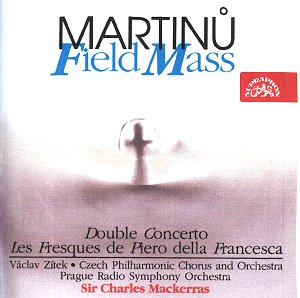Charles Mackerras has
long been a devoted friend of Czech music. I remember that Pye LP of
Mackerras conducting Janáček's Sinfonietta with a
selection of the operatic preludes. The
Pye cover had a photograph the sixteen trumpeters deployed across the
full breadth of the orchestra. This was at a time when Janáček
had hardly any profile in the UK and where, in the fame stakes, Martinů
probably ranked slightly higher. The balance has shifted since
then with Taras, Sinfonietta, the Glagolytic Mass and
above all the operas having secured a far warmer place in the sun for
Janáček than that accorded to Martinů.
On this disc Martinů's
most recorded work rubs shoulders with two slightly lesser known
pieces. The Double Concerto (to be distinguished from his other double
concerto for violin, piano and orchestra - curiously neglected on CD)
has an oppressive claustrophobic atmosphere as well as a ferocious release
of adrenalin. This is a work that is predictive of the same explosion
of dynamic interest, cross-rhythms and melodic profusion that we associate
with his American years (early 1940s onwards). I am not sure I can easily
find a parallel for this supercharged pressure. The closest I can point
to is the Bax Second Symphony (from the early 1920s) where the composer
conjures a bass-heavy murmur that has you staring down into a colossal
tempestuously wheeling whirlpool.
Sejna’s Martinů Double
Concerto (on a still available Supraphon coupled with an abysmal sounding
Martinů Third Symphony) has always been a connoisseurs’ choice
however he is not without competition. The Supraphon sound is coarse
textured but very strong and close - somehow fitting for a work that
sounds a little like the Tallis Fantasia on speed and
laced with cordite, grief and tragedy. The piano acts as a centre-stage
orator intensifying and explaining. The Sejna sound amplifies the sense
of cataclysm and stalking hysteria. Mackerras on a modern sounding Conifer
CDCF210 is a strong contender though ‘his’ piano is made to sound like
a rather pebbly pianola much improved on the disc under current consideration.
The Conifer Brno State PO is lean with whip-sharp reflexes and just
the right acidic aggression. Amongst the other competition
the most colossal is the Bělohlávek on Chandos CHAN8950. Macura,
on a difficult to locate Panton 81 1204-20111, is big on impact without
Bělohlávek’s blessing of Chandos luxury sound. My how he taps the
anguish and hysteria in this score! The DePreist BIS version,
audio-technically speaking, is ennervatingly distanced and I could not
recommend it. Conlon’s take on the work (on an Ultima double) is well
worth exploring. His controlled interleaved waves of string-sound in
the Largo hold you in the cup of his hand though I suppose some
may find it mannered. Conlon’s French orchestra is not quite the luxury
vehicle enjoyed by Bělohlávek or by
Mackerras in this latest Supraphon. None of these versions is poor as
an interpretation. The DePreist can be eliminated only because the recording
lacks close-up grip though, ironically, it is probably the most representative
of a concert experience in a big hall with the listener sitting
in ‘the Gods’. The Conlon stays with me because of his memorable way
with the Largo. Go for the Chandos for an excellent interpretation
in gold bullion sound. The Macura (stereo) and the Sejna (historic mono)
are older and are well worth considering. Some of you will have learnt
your first Martinů through the Sejna LP and need have no reservations
about returning to it now. Mackerras gives the most intense performance
- little to choose between the two on character. Truth to tell
you cannot really go wrong with any of these though I do urge caution
with the BIS.
Double Concerto I II III
Mackerras (Supraphon) 6.22 8.29 6.41
Mackerras (Conifer) 6.25 8.21 6.59
Sejna (Supraphon) 6.25 8.40 7.01
DePreist (BIS) 6.39 8.09 6.28
Bělohlávek (Chandos) 6.42 8.14 6.45
Macura (Panton) 6.54 8.24 6.54
The Field Mass is, broadly speaking, contemporaneous
with the Double Concerto. The work was written in Paris with the war
two months old, written in the bow-wave of the Blitzkrieg that
saw old Europe's walls pulverised. Truth to tell it is not melodically
the most striking of Martinů's inspirations. A Prom performance
a couple of years back left me completely unmoved. However it has a
striking sound-world all its own as men's voices are ranged with
and against wind, percussion, piano and harmonium. Perhaps this is a
credible battlefield instrumentation. There is a touch of nostalgia
for pastoral and civic homelands but the determination and dedication
to conflict are what rises most readily from this performance. To the
best of my knowledge there are currently no alternative recordings.
Finally we come to a work whose vivid painterly qualities
match adroitly the subject matter: the Frescos of Piero della Francesca.
Most of us long-time Martinů hunters
will have first heard the piece as the coupling with Turnovsky's version
of the Fourth Symphony. This was on a 1960s Supraphon LP. It is a late
work from 1954 and its drench of colour in motion has its counterpart
in the artwork of that Orphic Robin Williams film of a couple
of years back There are no hard edges so it cannot entirely be a mosaic
kaleidoscope. Rather it is a melting river of colours in constant flux.
The three movements represent an active meditation on the wall paintings
of Piero della Francesca in Arezzo in Italy. It is extremely well done
by both Supraphon and Mackerras.
The notes are good and are well translated and designed.
Full texts and translations are given. All around a quality product.
A more impressively recorded, imagined and executed introduction would
be difficult conceive.
Rob Barnett
